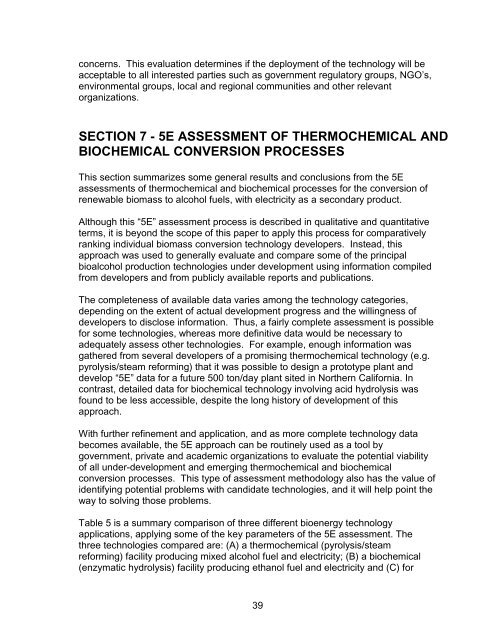Assessment of Conversion Technologies for Bioalcohol Fuel ...
Assessment of Conversion Technologies for Bioalcohol Fuel ...
Assessment of Conversion Technologies for Bioalcohol Fuel ...
Create successful ePaper yourself
Turn your PDF publications into a flip-book with our unique Google optimized e-Paper software.
concerns. This evaluation determines if the deployment <strong>of</strong> the technology will be<br />
acceptable to al interested parties such as government regulatory groups, NGO’s,<br />
environmental groups, local and regional communities and other relevant<br />
organizations.<br />
SECTION 7 - 5E ASSESSMENT OF THERMOCHEMICAL AND<br />
BIOCHEMICAL CONVERSION PROCESSES<br />
This section summarizes some general results and conclusions from the 5E<br />
assessments <strong>of</strong> thermochemical and biochemical processes <strong>for</strong> the conversion <strong>of</strong><br />
renewable biomass to alcohol fuels, with electricity as a secondary product.<br />
Although this “5E”assessment process is described in qualitative and quantitative<br />
terms, it is beyond the scope <strong>of</strong> this paper to apply this process <strong>for</strong> comparatively<br />
ranking individual biomass conversion technology developers. Instead, this<br />
approach was used to generally evaluate and compare some <strong>of</strong> the principal<br />
bioalcohol production technologies under development using in<strong>for</strong>mation compiled<br />
from developers and from publicly available reports and publications.<br />
The completeness <strong>of</strong> available data varies among the technology categories,<br />
depending on the extent <strong>of</strong> actual development progress and the willingness <strong>of</strong><br />
developers to disclose in<strong>for</strong>mation. Thus, a fairly complete assessment is possible<br />
<strong>for</strong> some technologies, whereas more definitive data would be necessary to<br />
adequately assess other technologies. For example, enough in<strong>for</strong>mation was<br />
gathered from several developers <strong>of</strong> a promising thermochemical technology (e.g.<br />
pyrolysis/steam re<strong>for</strong>ming) that it was possible to design a prototype plant and<br />
develop “5E” data <strong>for</strong> a future 500 ton/day plant sited in Northern Cali<strong>for</strong>nia.In<br />
contrast, detailed data <strong>for</strong> biochemical technology involving acid hydrolysis was<br />
found to be less accessible, despite the long history <strong>of</strong> development <strong>of</strong> this<br />
approach.<br />
With further refinement and application, and as more complete technology data<br />
becomes available, the 5E approach can be routinely used as a tool by<br />
government, private and academic organizations to evaluate the potential viability<br />
<strong>of</strong> all under-development and emerging thermochemical and biochemical<br />
conversion processes. This type <strong>of</strong> assessment methodology also has the value <strong>of</strong><br />
identifying potential problems with candidate technologies, and it will help point the<br />
way to solving those problems.<br />
Table 5 is a summary comparison <strong>of</strong> three different bioenergy technology<br />
applications, applying some <strong>of</strong> the key parameters <strong>of</strong> the 5E assessment. The<br />
three technologies compared are: (A) a thermochemical (pyrolysis/steam<br />
re<strong>for</strong>ming) facility producing mixed alcohol fuel and electricity; (B) a biochemical<br />
(enzymatic hydrolysis) facility producing ethanol fuel and electricity and (C) <strong>for</strong><br />
39
















